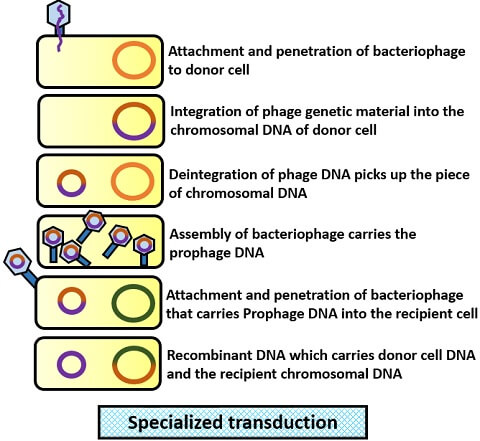Transduction is a mechanism of genetic recombination that occurs in bacteria where the incorporation of host cell DNA and the bacteriophage genetic material occurs, which results in the formation of recombinant DNA. It was given by scientists in 1952 by Norton Zinder and Joshua Lederberg. Bacterial transduction occurs through generalized and specialized transduction.
In generalized type, any of the genes can be transduced of the host cell, whereas only special genes are transduced in specialized type. The process of transduction was first studied in the bacterium Salmonella.
Today, molecular biologists use transduction principle to introduce a foreign gene into the host-cell genome. In this context, the definition, generalized and specialized type of transduction are explained.
Content: Transduction
Definition of Transduction
Transduction is the gene transfer mechanism, which facilitates the transfer of genetic material from one bacterial cell to the next bacterial cell by the bacteriophages (as the vectors). The insertion of foreign DNA by the bacteriophages from a donor cell to a recipient cell also defines the process of transduction. Unlike bacterial conjugation, the transduction method does not involve the association of the donor and recipient cell. It is a gene-transfer mechanism that shows resistance towards DNase enzyme, unlike transformation.
Types
The transduction in bacteria occurs in two ways, either through a lytic or lysogenic cycle:

Generalized Transduction
It is the kind of Lytic phase, in which the bacteriophage only carries the pure bacterial DNA, not the phage DNA and this pure bacterial gene is inserted into the recipient cell.
Process
It includes the following steps:

- Firstly, the bacteriophage attacks the bacterial cell (donor cell).
- The bacteriophage injects its genetic material, which then penetrates the bacterial chromosome.
- The phage DNA then controls the host cell machinery. This cause the degradation of the bacterial chromosomal DNA, which results in small fragments of the genetic material.
- The replication of phage DNA occurs. At the time of packaging, the genetic material of the bacterial DNA accidentally gets into the bacteriophages by a phenomenon called “False packaging”.
- Then, the biosynthesis of bacteriophages occurs, and the phages get to assemble and finally cause lysis of the donor cell.
- The bacteriophages then attack the other bacterial cell (recipient cell), and again it will penetrate its phage DNA into the host cell.
- The phage DNA will incorporate in the recipient’s DNA and leads to the formation of a recombinant cell.
Specialized Transduction
It is the kind of Lysogenic phase, in which the gene transfer occurs from one bacterial cell to the next via bacteriophages that do not carry the pure bacterial DNA, i.e. it contains both the bacterial DNA and the phage DNA.
Process
It includes the following steps:

- First, the bacteriophage attack the bacterial cell or donor cell.
- Then, the genetic material of the bacteriophage will penetrate the bacterial chromosome.
- The phage DNA will incorporate within the bacterial DNA and then it will start the replication cycle.
- The phage DNA then control over the cell machinery of the bacteria. This cause the assembly of the bacteriophages that consist of both phage and donor’s DNA.
- After that, a UV-light induces cell lysis and results in the release of lysogens.
- Then, the bacteriophages attack the other bacterial cell (recipient cell). This bacteriophage will penetrate the prophage DNA into the recipient cell.
- The phage DNA and the donor cell DNA will incorporate in the recipient’s DNA, which leads to the formation of the recombinant cell.
Conclusion
Therefore, the transduction is the molecular biological technique that helps in the gene alternation or gene recombination. The process of transduction is either generalized or specialized, depending upon the type packaging of the viral genome.
I just love this web site.
Thank you so much 💜